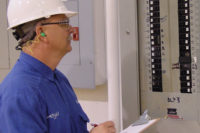Previous editions of NFPA 70E required an arc flash hazard analysis. The 2015 edition now requires an arc flash risk assessment to determine if an arc flash hazard exists. If it does exist, the employer must now determine the risk to employees and the required safe work practices and personal protective equipment (PPE). Are your employees trained in the latest requirements of NFPA 70E-2015 needed to perform risk assessments? Do they know the risks of electrical hazards?
A safe state
NFPA 70E-2015 states that training requirements apply to all employees who are exposed to electrical hazards where the risk associated with the hazards has not been reduced to a safe level by the installation requirements. The installation requirements of the National Electrical Code (NEC) require all electrical equipment to have all covers or hinged panels installed and securely fastened closed, so there are no exposed energized (live) conductors or parts of equipment. In this condition, there is essentially no shock hazard or risk of an electrical shock or electrocution occurring. Also, in the installed state, the equipment is not being operated manually or by automatic means; it is essentially stagnant in this state, which reduces the risk of an arc flash occurring.
|
Reality check
We all know the realities of electrical systems in industrial and commercial facilities. Covers are removed and equipment doors are opened in order to perform maintenance and testing of the equipment, which exposes personnel to energized circuits and the potential for electrical shock or electrocution, as well as arc flash burns. Most electrical equipment is operated manually or automatically on a regular basis, often several times a day. If the equipment fails to operate properly, an arc flash may occur. If the equipment is being operated manually or maintenance is being performed with the covers off or the doors open, and an arc flash occurs, the person(s) in close proximity are at risk of serious injury or death from arc flash burns.
Now let’s go back to the training requirements addressed earlier. The requirement stated that “employees who are exposed to electrical hazards” which means all employees, not just electricians. There may be a safety backup assigned to a job; an equipment operator or a mechanic who will open or close a circuit breaker or disconnect switch; an electrician who is racking a power circuit breaker out or in; or it may be an office worker, a janitor, a laborer, or any other employee who is using cord- and plug-connected electric equipment or extension cords; are each of these workers trained in electrical safety?
Assess, train & protect
Electrical hazards associated with electrical equipment and systems do exist, but how do you know what they are? OSHA requires the employer to “assess the workplace to determine if hazards are present, or are likely to be present, which necessitate the use of PPE.” NFPA 70E requires a risk assessment of the electrical hazards in the workplace and the use of the appropriate PPE and safe work practices to protect employees. OSHA and NFPA 70E require the employer to train employees to understand the specific hazards associated with electrical energy. They go on to require the training to include safe work practices and procedures and protection techniques applicable to the electrical hazards, based on the employee’s respective job or task assignments. All employees must be trained to identify and understand the electrical hazards and the risk of injury associated with the tasks they are required to perform.
Shock & arc flash risk
A major focus of NFPA 70E is the risk assessments for shock and arc flash. The shock risk assessment must determine the voltage, the shock boundaries, and the required PPE to protect employees from the shock hazard. The arc flash risk assessment first determines if an arc flash hazard exists. If an arc flash hazard exists, the employer then determines safe work practices, the arc flash boundary, and the required PPE.
Reduce the risk
NFPA 70E states the way to reduce the risk of electrical hazards, and the risks associated with the hazards, is to establish an electrically safe work condition prior to working on electrical equipment. Keep in mind that during the process of establishing an electrically safe work condition, the employee is at risk. OSHA states that the energy control requirements must be met before any circuits or equipment can be considered and worked as deenergized. Until the procedures for establishing an electrically safe work condition have been completed, the circuits and equipment are considered energized and all applicable safe work practices and PPE must be used to protect employees from any potential shock or arc flash hazards.
There are exceptions to the requirement to establish an electrically safe work condition that include situations where deenergizing would introduce additional or increased hazards; or is infeasible due to equipment or operational limitations; or the circuits or equipment are less than 50 volts and there is no danger of electrical burns or explosion; or under normal operation where the equipment is properly installed and maintained, all doors are closed and secured, all covers are in place and secured, and there is no evidence of impending failure. Properly installed means the equipment was installed in accordance with industry standards and codes. Properly maintained means the equipment is maintained according to the manufacturer’s instructions or applicable industry standards or codes. Evidence of impending failure could include loose, bent or broken parts, visible damage, overheating, or arcing.
Successful electrical safety
Training all employees to recognize and avoid hazards is key to a successful electrical safety program. It is recommended that a job/task analysis and task hazard analysis, including the shock and arc flash risk assessments, be performed in order to define the job description of all employees. Completing this analysis and risk assessment can help determine employees’ exposure or potential exposure to electrical hazards in the workplace. It can also establish the basis upon which the electrical safety program and procedures are written and determine the training requirements for all employees who may be exposed to electrical hazards.



